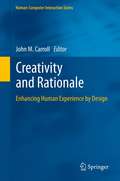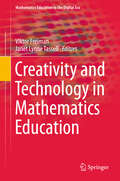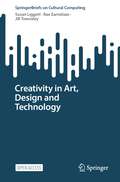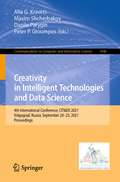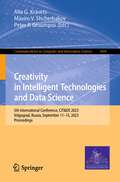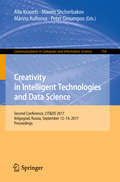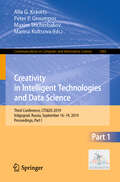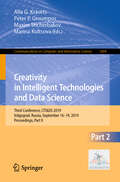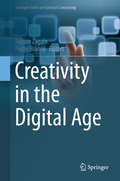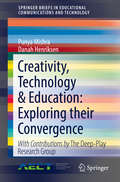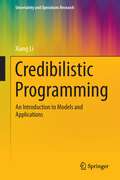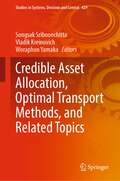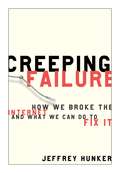- Table View
- List View
Creativity and Rationale: Enhancing Human Experience by Design (Human–Computer Interaction Series #20)
by John M. CarrollCreativity and rationale comprise an essential tension in design. They are two sides of the coin; contrary, complementary, but perhaps also interdependent. Designs always serve purposes. They always have an internal logic. They can be queried, explained, and evaluated. These characteristics are what design rationale is about. But at the same time designs always provoke experiences and insights. They open up possibilities, raise questions, and engage human sense making. Design is always about creativity. Creativity and Rationale: Enhancing Human Experience by Design comprises 19 complementary chapters by leading experts in the areas of human-computer interaction design, sociotechnical systems design, requirements engineering, information systems, and artificial intelligence. Researchers, research students and practitioners in human-computer interaction and software design will find this state of the art volume invaluable.
Creativity and Technology in Mathematics Education (Mathematics Education in the Digital Era #10)
by Viktor Freiman Janet Lynne TassellThis volume provides new insights on creativity while focusing on innovative methodological approaches in research and practice of integrating technological tools and environments in mathematics teaching and learning. This work is being built on the discussions at the mini-symposium on Creativity and Technology at the International Conference on Mathematical Creativity and Giftedness (ICMCG) in Denver, USA (2014), and other contributions to the topic. The book emphasizes a diversity of views, a variety of contexts, angles and cultures of thought, as well as mathematical and educational practices. The authors of each chapter explore the potential of technology to foster creative and divergent mathematical thinking, problem solving and problem posing, creative use of dynamic, multimodal and interactive software by teachers and learners, as well as other digital media and tools while widening and enriching transdisciplinary and interdisciplinary connections in mathematics classroom. Along with ground-breaking innovative approaches, the book aims to provide researchers and practitioners with new paths for diversification of opportunities for all students to become more creative and innovative mathematics learners. A framework for dynamic learning conditions of leveraging mathematical creativity with technology is an outcome of the book as well.
Creativity in Art, Design and Technology (Springer Series on Cultural Computing)
by Rae Earnshaw Susan Liggett Jill TownsleyThis is an open access book.Creativity is a difficult concept, how can it best be defined, understood, applied, and practiced? This book provides important answers to these questions. Technology can enable artists to be more creative. Scientific and artistic thinking give us two complementary tools to understand the complexity of the world, with science reducing subjective experience to essential principles and art intensifying and expanding our experiences. These examples also show how artists can push the boundaries of technology into exciting new realms that have not been explored before. The impact that art and art practice can have on culture, society, and social responsibility is explored in detail through examples and case studies. In addition, the book presents how artists are creating and reflecting cultural and societal resonance in their work. Can other disciplines help artists to be more creative? All are part of an interrelated wider society and enables artists to develop artwork fit for highly interfaced and conceptually broad contemporary contexts. This is illustrated with examples which show exciting and challenging results. Creativity in Art, Design and Technology is relevant for artists, designers, scientists and technologists. All can benefit in a major way from a greater understanding of creativity, and the ways in which mutual interaction and collaboration enables all areas to develop. The potential for the future is immense and this book signposts the way forward.
Creativity in Intelligent Technologies and Data Science: 4th International Conference, CIT&DS 2021, Volgograd, Russia, September 20–23, 2021, Proceedings (Communications in Computer and Information Science #1448)
by Maxim Shcherbakov Alla G. Kravets Peter P. Groumpos Danila ParyginThis book constitutes the proceedings of the 4th Conference on Creativity in Intellectual Technologies and Data Science, CIT&DS 2021, held in Volgograd, Russia, in September 2021.The 39 full papers, 7 short papers, and 2 keynote papers presented were carefully reviewed and selected from 182 submissions. The papers are organized in the following topical sections: Artificial intelligence and deep learning technologies: knowledge discovery in patent and open sources; open science semantic technologies; IoT and computer vision in knowledge-based control; Cyber-physical systems and big data-driven control: pro-active modeling in intelligent decision making support; design creativity in CASE/CAI/CAD/PDM; intelligent technologies in urban design and computing; Intelligent technologies in social engineering: data science in social networks analysis and cyber security; educational creativity and game-based learning; intelligent assistive technologies: software design and application.
Creativity in Intelligent Technologies and Data Science: 5th International Conference, CIT&DS 2023, Volgograd, Russia, September 11–15, 2023, Proceedings (Communications in Computer and Information Science #1909)
by Alla G. Kravets Peter P. Groumpos Maxim V. ShcherbakovThis book constitutes the proceedings of the 5th Conference on Creativity in Intellectual Technologies and Data Science, CIT&DS 2023, held in Volgograd, Russia, in September 2023.The 40 regular papers and 2 keynote papers presented were carefully reviewed and selected from 148 submissions. The papers are organized in the following topical sections: Artificial intelligence and deep learning technologies for creative tasks. Knowledge discovery in patent and open sources; Artificial intelligence & Deep Learning Technologies for Creative tasks. Open science semantic technologies; Artificial intelligence and deep learning technologies for creative tasks. Computer vision and knowledge-based control; Cyber-physical systems and big data-driven control: pro-active modeling in intelligent decision making support; Cyber-Physical Systems & Big Data-driven world. Industrial creativity in CASE/CAI/CAD/PDM; Cyber-Physical Systems & Big Data-driven world. Intelligent Internet of Services and Internet of Things; Intelligent Technologies in Social Engineering. Data Science in Social Networks Analysis and Cyber Security; Intelligent Technologies in Social Engineering. Creativity & Game-Based Learning; Intelligent Technologies in Social Engineering. Intelligent Technologies in Medicine& Healthcare; Intelligent Technologies in Social Engineering. Intelligent technologies in Urban Design&Computing.
Creativity in Intelligent Technologies and Data Science: Second Conference, CIT&DS 2017, Volgograd, Russia, September 12-14, 2017, Proceedings (Communications in Computer and Information Science #754)
by Alla Kravets Maxim Shcherbakov Marina Kultsova Peter GroumposThis book constitutes the refereed proceedings of the First Conference on Creativity in Intelligent Technologies and Data Science, CIT&DS 2015, held in Volgograd, Russia, in September 2015. The 66 revised full papers and two short papers presented were carefully reviewed and selected from 208 submissions. The papers are organized in topical sections on computational creativity for science and design; knowledge discovery in patent and open sources for creative tasks; software computer-aided design and agent-based systems; conceptual, cognitive and qualitative modeling with application in intelligent decision making; design creativity in CAD/CAM/CAE/PDM; intelligent decision support for continual improvement process; data science in energy management, transportation and urban development; data science in social networks analysis; natural language and image processing and analysis; game-based learning technologies in engineering education and educational games design; personalized learning in Web-based intelligent educational systems; e-inclusion: development of smart mobile applications for people with disabilities.
Creativity in Intelligent Technologies and Data Science: Third Conference, CIT&DS 2019, Volgograd, Russia, September 16–19, 2019, Proceedings, Part I (Communications in Computer and Information Science #1083)
by Maxim Shcherbakov Marina Kultsova Alla G. Kravets Peter P. GroumposThis two-volume set constitutes the proceedings of the Third Conference on Creativity in Intellectual Technologies and Data Science, CIT&DS 2019, held in Volgograd, Russia, in September 2019.The 67 full papers, 1 short paper and 3 keynote papers presented were carefully reviewed and selected from 231 submissions. The papers are organized in topical sections in the two volumes. Part I: cyber-physical systems and Big Data-driven world. Part II: artificial intelligence and deep learning technologies for creative tasks; intelligent technologies in social engineering.
Creativity in Intelligent Technologies and Data Science: Third Conference, CIT&DS 2019, Volgograd, Russia, September 16–19, 2019, Proceedings, Part II (Communications in Computer and Information Science #1084)
by Maxim Shcherbakov Marina Kultsova Alla G. Kravets Peter P. GroumposThis two-volume set constitutes the proceedings of the Third Conference on Creativity in Intellectual Technologies and Data Science, CIT&DS 2019, held in Volgograd, Russia, in September 2019.The 67 full papers, 1 short paper and 3 keynote papers presented were carefully reviewed and selected from 231 submissions. The papers are organized in topical sections in the two volumes. Part I: cyber-physical systems and Big Data-driven world. Part II: artificial intelligence and deep learning technologies for creative tasks; intelligent technologies in social engineering.
Creativity in the Digital Age (Springer Series on Cultural Computing)
by Nelson Zagalo Pedro BrancoThis edited book discusses the exciting field of Digital Creativity. Through exploring the current state of the creative industries, the authors show how technologies are reshaping our creative processes and how they are affecting the innovative creation of new products. Readers will discover how creative production processes are dominated by digital data transmission which makes the connection between people, ideas and creative processes easy to achieve within collaborative and co-creative environments. Since we rely on our senses to understand our world, perhaps of more significance is that technologies through 3D printing are returning from the digital to the physical world. Written by an interdisciplinary group of researchers this thought provoking book will appeal to academics and students from a wide range of backgrounds working or interested in the technologies that are shaping our experiences of the future.
Creativity, Technology & Education: Exploring their Convergence (SpringerBriefs in Educational Communications and Technology)
by Danah Henriksen Punya MishraIn this collection of beautifully written essays, Mishra, Henriksen, and the Deep-play Research Group challenge myths about technology and creativity, debate time-honored instructional practices, and play with new ideas for schools to care for and nurture, rather than constrain, creativity. These essays are provocative . . . refreshing, [and] insightful --Dr. Yong Zhao, Foundation Distinguished Professor, University of Kansas and Fellow, Mitchell Institute for Health and Education Policy, Victoria University, Australia. What is creativity? Why is it important? What does it look like across different disciplines and contexts? What role does technology play, if any, in the creative process? And finally, what do creativity and technology have to do with education? These are the questions that underlie the collection of articles in this book. These essays provide a broad analytic frame for thinking about creativity, technology and education and describe classroom examples as well as strategies for evaluating creative artifacts and creative environments. All of these are grounded in specific examples from across a wide range of disciplines and contexts--art, mathematics, engineering, computer science, graphic design, architecture, science to name just a few. The final essays take a broader perspective on creativity and technology focusing both on our highly inter-connected YouTube world but also possibilities for the future. Creativity, Technology & Education: Exploring their Convergence is a vital resource for educators and practitioners as they seek to incorporate creative work and thoughtful pedagogy in their personal and professional lives.
Creator Culture: An Introduction to Global Social Media Entertainment
by David Craig Stuart CunninghamExplores new perspectives on social media entertainmentThere is a new class of cultural producers—YouTube vloggers, Twitch gameplayers, Instagram influencers, TikTokers, Chinese wanghong, and others—who are part of a rapidly emerging and highly disruptive industry of monetized “user-generated” content. As this new wave of native social media entrepreneurs emerge, so do new formations of culture and the ways they are studied.In this volume, contributors draw on scholarship in media and communication studies, science and technology studies, and social media, Internet, and platform studies, in order to define this new field of study and the emergence of creator culture. Creator Culture introduces readers to new paradigms of social media entertainment from critical perspectives, demonstrating both relations to and differentiations from the well-established media forms and institutions traditionally within the scope of media studies.This volume does not seek to impose a uniform perspective; rather, the goal is to stimulate in-depth, globally-focused engagement with this burgeoning industry and establish a dynamic research agenda for scholars, teachers, and students, as well as creators and professionals across the media, communication, creative, and social media industries.Contributors include: Jean Burgess, Zoë Glatt, Sarah Banet-Weiser, Brent Luvaas, Carlos A. Scolari, Damián Fraticelli, José M. Tomasena, Junyi Lv, Hector Postigo, Brooke Erin Duffy, Megan Sawey, Jarrod Walzcer, Sangeet Kumar, Sriram Mohan, Aswin Punathambekar, Mohamed El Marzouki, Elaine Jing Zhao, Arturo Arriagada, Jeremy Shtern, Stephanie Hill
Creators Take Control: How NFTs Revolutionize Art, Business, and Entertainment
by Edward LeeA leading legal scholar offers a compelling new theory to explain the meteoric rise of non-fungible tokens (NFTs) and their impact on art, business, entertainment, and society, and explains how they are revolutionizing our understanding of ownership.If you buy an NFT, do you own anything? Critics say no. Then why are people spending so much money to own them—to the tune of $27 billion in 2021? And why are big businesses and venture capital firms investing hundreds of millions to develop NFTs for people’s use in the metaverse, a purely imaginary world? In Creators Take Control, Edward Lee offers a compelling new theory he calls “Tokenism” that answers these perplexing questions. Using vivid examples, Lee lucidly explains how NFTs operate—and how they fundamentally change our understanding of ownership. Tokenism is an artistic, cultural, and technological movement that creates value in a new kind of ownership of a new type of property—symbolized by a virtual token—through a process of technological abstraction and artificial scarcity effectuated by NFTs. Ownership becomes virtual. What Cubism did in radically changing the twentieth-century perspective of creating and viewing art through cubes, Tokenism does today in altering our perspective of owning art and other things through tokens. Both movements radically reimagine what’s possible. Creators and businesses have seized upon this profound transformation. In a short time, they have developed a new market for digital art, important new rights for creators, innovative business models based on decentralized collaboration, and a new type of interactive ownership that enables identity, community, and patronage through NFTs. These innovations are just the start of revolutionary changes to society. Lee shows how NFTs create a new form of decentralized intellectual property, or De-IP. Comparable to the movement to decentralized finance (DeFi), De-IP empowers creators to take control of their artistic productions and livelihood. Lee’s intellectual tour de force is filled with practical insights—and hope—for fostering creativity and a Virtual Renaissance for the ages.
Creators of Intelligence: Industry secrets from AI leaders that you can easily apply to advance your data science career
by John K. Thompson Dr. Alex AnticGet your hands on the secret recipe for a rewarding career in data science from 18 AI leadersPurchase of the print or Kindle book includes a free PDF eBookKey FeaturesGain access to insights and expertise from data science leaders shared in one-on-one interviewsGet pragmatic advice on how to become a successful data scientist and data science leaderReceive guidance to overcome common pitfalls and challenges and ensure your projects' successBook DescriptionA Gartner prediction in 2018 led to numerous articles stating that "85% of AI and machine learning projects fail to deliver.” Although it's unclear whether a mass extinction event occurred for AI implementations at the end of 2022, the question remains: how can I ensure that my project delivers value and doesn't become a statistic? The demand for data scientists has only grown since 2015, when they were dubbed the new “rock stars” of business. But how can you become a data science rock star? As a new senior data leader, how can you build and manage a productive team? And what is the path to becoming a chief data officer? Creators of Intelligence is a collection of in-depth, one-on-one interviews where Dr. Alex Antic, a recognized data science leader, explores the answers to these questions and more with some of the world's leading data science leaders and CDOs. Interviews with: Cortnie Abercrombie, Edward Santow, Kshira Saagar, Charles Martin, Petar Velickovic, Kathleen Maley, Kirk Borne, Nikolaj Van Omme, Jason Tamara Widjaja, Jon Whittle, Althea Davis, Igor Halperin, Christina Stathopoulos, Angshuman Ghosh, Maria Milosavljevic, Dr. Meri Rosich, Dat Tran, and Stephane Doyen.What you will learnFind out where to start with AI ethics and how to evolve from frameworks to practiceDiscover tips on building and managing a data science teamReceive advice for organizations seeking to build or mature a data science capabilityStop beating your head against a brick wall – pick the environment that'll support your successRead stories from successful data leaders as they reflect on the successes and failures in data strategy developmentUnderstand how business areas can best work with data science teams to drive business valueWho this book is forThis book is for a wide range of audience, from people working in the data science industry through to data science leaders and chief data officers. This book will also cater to senior business leaders interested in learning how data and analytics are used to support decision-making in different domains and sectors. Students contemplating a career in artificial intelligence (AI) and the broader data sector will also find this book useful, along with anyone developing and delivering university-level education, including undergraduate, postgraduate, and executive programs.
Creatures of Politics: Media, Message, and the American Presidency
by Michael Silverstein Michael LempertThis analysis of campaign messaging and image-making is “a fascinating read and an illuminating look into the complex realm of political rhetoric” (Publishers Weekly).It’s a common complaint that a presidential candidate’s style matters more than substance and that the issues have been eclipsed by mass-media-fueled obsession with a candidate’s every slip, gaffe, and peccadillo. This book explores political communication in American presidential politics, focusing on what insiders call “message.”Message, Michael Lempert and Michael Silverstein argue, is not simply an individual’s positions on the issues but the craft used to fashion the creature the public sees as the candidate. Lempert and Silverstein examine some of the revelatory moments in debates, political ads, interviews, speeches, and talk shows to explain how these political creations come to have a life of their own. From the pandering “Flip-Flopper” to the self-reliant “Maverick,” the authors demonstrate how these figures are fashioned out of the verbal, gestural, sartorial, behavioral—as well as linguistic—matter that comprises political communication.“This book captures better than any other the way ‘messaging’ works . . . their lively account of the culture of presidential communication remains sensitive to both the comedy and the seriousness of its subject.” —Michael Warner, Yale University
Credibilistic Programming: An Introduction to Models and Applications (Uncertainty and Operations Research)
by Xiang LiIt provides fuzzy programming approach to solve real-life decision problems in fuzzy environment. Within the framework of credibility theory, it provides a self-contained, comprehensive and up-to-date presentation of fuzzy programming models, algorithms and applications in portfolio analysis.
Credible Asset Allocation, Optimal Transport Methods, and Related Topics (Studies in Systems, Decision and Control #429)
by Vladik Kreinovich Songsak Sriboonchitta Woraphon YamakaThis book describes state-of-the-art economic ideas and how these ideas can be (and are) used to make economic decision (in particular, to optimally allocate assets) and to gauge the results of different economic decisions (in particular, by using optimal transport methods). Special emphasis is paid to machine learning techniques (including deep learning) and to different aspects of quantum econometrics—when quantum physics and quantum computing models are techniques are applied to study economic phenomena. Applications range from more traditional economic areas to more non-traditional topics such as economic aspects of tourism, cryptocurrencies, telecommunication infrastructure, and pandemic. This book helps student to learn new techniques, practitioners to become better knowledgeable of the state-of-the-art econometric techniques, and researchers to further develop these important research directions
Creeper Family Vacation: The Creeper Diaries, An Unofficial Minecrafter's Novel (Creeper Diaries #5)
by Amanda Brack Greyson MannCan Gerald survive vacation with his crazy family? The Creeper family is planning a month-long summer vacation! But where will they go? On a road trip across the Overworld? Backpacking in the Extreme Hills? Camping out in caves? Gerald and his sisters can't agree! When Dad suggests they do all three, Gerald hops on board. But he quickly realizes that the only thing worse than being stuck with his sisters at home is being stuck with them in a minecart for hours on end. Cammy is so excited, she keeps blowing up. Cate is sulking because she couldn't pack all her wigs. And Chloe is determined to stir up trouble wherever they go—and she’s dragging Gerald right along with her. Abandoned mineshafts? Let's check 'em out! Miners? Let's freak 'em out! Cave spiders? Let's blow them into oblivion! To get through this vacation, Gerald is going to have to get creative—and come up with a serious survival plan.
Creeper Invasion: An Unofficial Minetrapped Adventure, #5 (The Unofficial Minetrapped Adventure #5)
by Winter MorganThe three friends trapped in their Minecraft game have never been closer to escaping the Overworld, and they can’t wait to return home after being trapped on the server for so long.But then a vicious horde of creepers attacks, delaying their escape. Soon the gang learns that there’s a new villain behind the attack: a griefer so twisted that he’d rather stay trapped in the Overworld than live a mundane life in the real world-and he has no qualms about keeping every other player trapped on the server with him. Can the friends and their new allies defeat the creepers, conquer their new enemy, and finally return home?Friends and enemies unite against evil in this exhilarating fifth book in bestselling author Winter Morgan’s Unofficial Minetrapped Adventure series.Sky Pony Press, with our Good Books, Racehorse and Arcade imprints, is proud to publish a broad range of books for young readers-picture books for small children, chapter books, books for middle grade readers, and novels for young adults. Our list includes bestsellers for children who love to play Minecraft; stories told with LEGO bricks; books that teach lessons about tolerance, patience, and the environment, and much more. While not every title we publish becomes a New York Times bestseller or a national bestseller, we are committed to books on subjects that are sometimes overlooked and to authors whose work might not otherwise find a home.
Creeper on the Case: The Creeper Diaries, An Unofficial Minecrafters Novel (Creeper Diaries #6)
by Amanda Brack Greyson MannWhen Gerald's mom says he should get more "involved" at school, he joins the newspaper staff. But reporting on current events is a snooze, until he stumbles onto a few mysteries. Why is Room 117 always locked? What is the disgusting smell coming out of Mr. Zane's briefcase? And . . . why is Gerald's best friend, Sam the Slime, suddenly acting so strangely? Someone has to figure out what's really going on at Mob Middle School. But never fear -- Gerald Creeper Jr., super sleuth, is here!
Creeper's Got Talent: The Creeper Diaries, An Unofficial Minecrafter's Novel (Creeper Diaries #2)
by Amanda Brack Greyson MannGerald made it through the first few weeks of Mob Middle School in one piece (give or take a limb), even if his quest for popularity hasn’t led to fame and glory yet. When he hears about the school’s upcoming talent show, Gerald sets his sights on a new plan: unveiling his hidden talents as a rapper. He can picture it already—kids will finally know his name. They'll beg for his autograph. Maybe he’ll even impress the super-popular Eddy Enderman!But Gerald’s got some rivals for that top spot, not the least of which is a band of spider jockeys determined to keep a sixth-grader from winning the show. His sister is determined to blow him out of the water with her cannonball trick. Even his best friend steps up the competition with his slime-block trampoline. In the second book of this hilarious, heavily illustrated, diary format series for Minecrafters, Gerald may win fame and glory—but what will he lose along the way?
Creepin' Through the Snow: The Creeper Diaries, An Unofficial Minecrafter's Novel, Special Edition (Creeper Diaries)
by Greyson MannA very special Christmas-themed Creeper Diaries adventure featuring the hilarious underdog narrator every Minecrafter can relate to!Gerald Creeper Jr. needs a new plan to survive the holidays. Why? Because he "accidentally" spent the emeralds his parents gave him to buy gifts. Oops! But no worries. He's sure he can make it all back by helping Sam the Slime put on a holiday show for little mobs in the neighborhood. Gerald can picture it already: he'll perform his new song "Rapping through the Snow." Everyone at Mob Middle School will love it!Instead, he's humiliated when Sam wraps him in twinkly lights and dubs him a talking Christmas tree. Gerald is ready to explode, until he meets a baby zombie with a special holiday wish. With a Santa skin, a wolf-drawn sleigh, and a potion of fire-resistance (to help him safely down the chimney), can he make her wish come true?This special Christmas edition of The Creeper Diaries, Creepin’ Through the Snow, is the third book in this laugh-out-loud funny, heavily illustrated, diary-format series for Minecrafters. This adventure series is created especially for readers who love the fight of good vs. evil, magical academies like Hogwarts in the Harry Potter saga, and games like Minecraft, Terraria, and Pokemon GO.
Creeping Failure: How We Broke the Internet and What We Can Do to Fix It
by Jeffrey HunkerThe Internet is often called a superhighway, but it may be more analogous to a city: an immense tangle of streets, highways, and interchanges, lined with homes and businesses, playgrounds and theatres. We may not physically live in this city, but most of us spend a lot of time there, and even pay rents and fees to hold property in it.But the Internet is not a city of the 21st century. Jeffrey Hunker, an internationally known expert in cyber-security and counter-terrorism policy, argues that the Internet of today is, in many ways, equivalent to the burgeoning cities of the early Industrial Revolution: teeming with energy but also with new and previously unimagined dangers, and lacking the technical and political infrastructures to deal with these problems. In a world where change of our own making has led to unexpected consequences, why have we failed, at our own peril, to address these consequences?Drawing on his experience as a top expert in information security, Hunker sets out to answer this critical question in Creeping Failure. Hunker takes a close look at the "creeping failures" that have kept us in a state of cyber insecurity: how and why they happened, and most crucially, how they can be fixed. And he arrives at some stunning conclusions about the dramatic measures that we will need to accomplish this.This groundbreaking book is an essential first step toward understanding the World Wide Web in a larger context as we try to build a safer Internet "city." But it also raises issues that are relevant far outside the online realm: for example, how can we work together to create not just new policy, but new kinds of policy? Creeping Failure calls for nothing less than a basic rethinking of the Internet -- and of how we solve problems together.From the Hardcover edition.
Creo Parametric 9.0 Tutorial
by Roger ToogoodThe eleven lessons in this tutorial introduce you to the design capabilities of Creo Parametric 9.0. The tutorial covers the major concepts and frequently used commands to advance from a novice to an intermediate user level. Major topics include part and assembly creation and the creation of engineering drawings. Also illustrated are the major functions that make Creo Parametric a parametric solid modeler. Although the commands are presented in a click-by-click manner, an effort has been made, in addition to showing/illustrating the command usage, to explain why certain commands are being used and the relation of feature selection and construction to the overall part design philosophy. Simply knowing where commands can be found is only half the battle. As is pointed out numerous times in the text, creating useful and effective models of parts and assemblies requires advance planning and forethought. Moreover, since error recovery is an important skill, considerable time is spent exploring the created models. In fact, some errors are intentionally induced so that users will become comfortable with the "debugging" phase of model creation. At the end of each lesson is a short quiz reviewing the new topics covered in that chapter. Following the quiz are several simple "exercise" parts that can be created using new commands taught in that lesson. In addition to these, an ongoing project is also included throughout the book. This project consists of several parts that are introduced with the early lessons and finally assembled at the end. Who this book is for This book has been written specifically with students in mind. Typically, students enter their first CAD course with a broad range of abilities, both in spatial visualization and computer skills. The approach taken here is meant to allow accessibility to persons of all levels. These lessons, therefore, were written for new users with no previous experience with CAD, although some familiarity with computers is assumed.
Criar humanos en un entorno digital: Cómo ayudar a los niños a tener una relación sana con la tecnología
by Diana GraberSexting, cyberbullying, la venganza del porno, depredadores en línea... todas estas amenazas potenciales pueden tentar a los padres a arrebatar de las manos de sus hijos, el teléfono inteligente o la tableta. Si bien la privación puede eliminar los peligros, ese enfoque también significa que su hijo se pierde los muchos beneficios y oportunidades de la tecnología.Criando humanos en un mundo digital muestra cómo los niños digitales deben aprender a navegar por este entorno, desde el equilibrio de la vida real y virtual hasta convertirse en modelos positivos y líderes.Este libro está lleno de temas de discusión en el hogar y actividades divertidas que cualquier familia ocupada puede realizar en su rutina diaria. Con una serie de consejos prácticos basados en la investigación académica y la experiencia práctica, los padres de hoy finalmente tienen lo que han estado esperando: una guía para criar niños digitales que se convertirán en los líderes positivos y exitosos que nuestro mundo necesita desesperadamente.
Criar humanos en un entorno digital: Cómo ayudar a los niños a tener una relación sana con la tecnología
by Diana GraberSexting, cyberbullying, la venganza del porno, depredadores en línea... todas estas amenazas potenciales pueden tentar a los padres a arrebatar de las manos de sus hijos, el teléfono inteligente o la tableta. Si bien la privación puede eliminar los peligros, ese enfoque también significa que su hijo se pierde los muchos beneficios y oportunidades de la tecnología.Criando humanos en un mundo digital muestra cómo los niños digitales deben aprender a navegar por este entorno, desde el equilibrio de la vida real y virtual hasta convertirse en modelos positivos y líderes.Este libro está lleno de temas de discusión en el hogar y actividades divertidas que cualquier familia ocupada puede realizar en su rutina diaria. Con una serie de consejos prácticos basados en la investigación académica y la experiencia práctica, los padres de hoy finalmente tienen lo que han estado esperando: una guía para criar niños digitales que se convertirán en los líderes positivos y exitosos que nuestro mundo necesita desesperadamente.Raising Humans in a Digital WorldSexting, cyberbullying, revenge porn, online predators… all of these potential threats can tempt parents to snatch the smartphone or tablet right out of their children&’s hands. While avoidance might eliminate the dangers, that approach also means your child misses out on technology&’s many benefits and opportunities.Raising Humans in a Digital World shows how digital kids must learn to navigate this environment, throughdeveloping social-emotional skillsbalancing virtual and real lifebuilding safe and healthy relationshipsavoiding cyberbullies and online predatorsprotecting personal informationidentifying and avoiding fake news and questionable contentbecoming positive role models and leaders.This book is packed with at-home discussion topics and enjoyable activities that any busy family can slip into their daily routine. Full of practical tips grounded in academic research and hands-on experience, today&’s parents finally have what they&’ve been waiting for—a guide to raising digital kids who will become the positive and successful leaders our world desperately needs.
